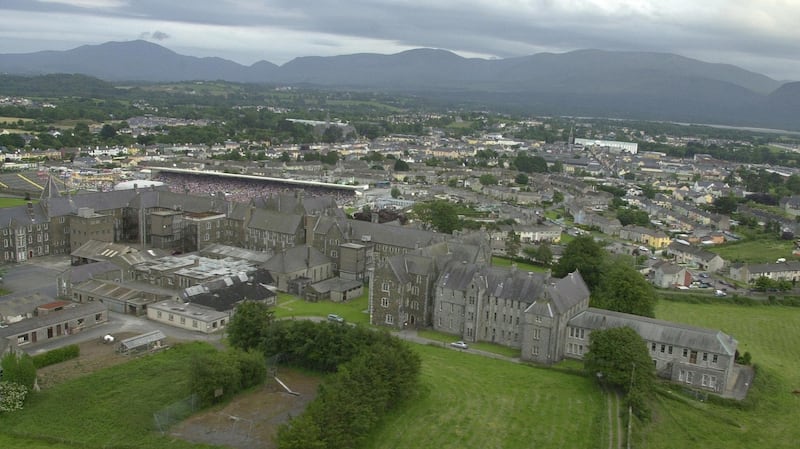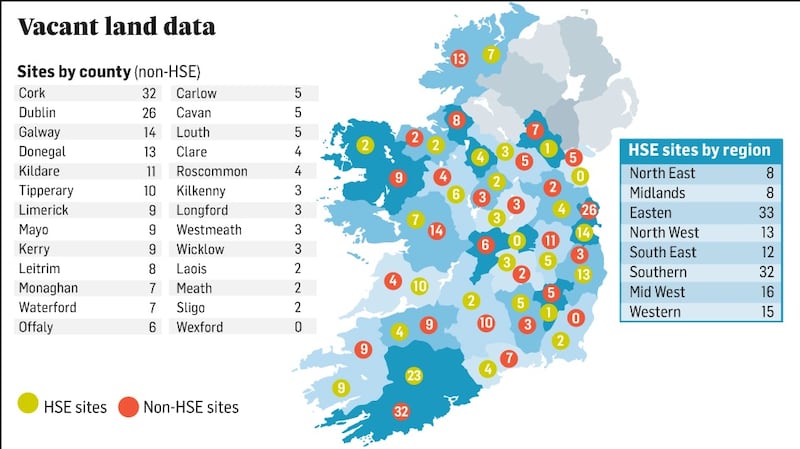Ireland’s chronic housing crisis has shone a spotlight on vacant land across the State, with calls to tax owners of such sites to force the hands of developers to return that land into use. Public ire is often directed at these supposed “land hoarding” developers, with politicians among their biggest critics.
Research by The Irish Times shows, however, that developers are not the only ones sitting on land banks. The Government, by virtue of some of the bodies under its aegis, have under its control a vast swathe of buildings and sites that have been unused – in some cases for more than 30 years.
There are, according to our analysis which follows parliamentary questions by Sinn Féin TD Peadar Tóibín, at least 334 unused buildings or sites owned by bodies which operate under the oversight of departments of the State. Some of these sites are as large as 131 acres; others are in prime city-centre locations.


“There’s no doubt that every organisation can’t have 100 per cent occupancy in its portfolio,” Mr Tóibín says. “However, given the fact that housing is the defining crisis of our time, it’s absolutely shocking that the State itself has so many unoccupied buildings and unoccupied land, some of that in very useful locations.”
And there is concern as to whether public records accurately reflect the full potential of publicly-owned land or buildings that lie vacant.
Two sites with a total value of €79 million, owned by Horse Racing Ireland, under the control of the Department of Agriculture, emerged recently as vacant. These two sites, however, weren't disclosed to us in the course of our investigation, suggesting there may be a considerably higher number of vacant sites around the State than we've been able to confirm.
Tóibín said the Government was misleading the Dáil through answers to parliamentary questions in relation to vacant buildings. “The non-disclosure of properties of such high value, in prime locations, is wrong,” he said.
Botched policies
Scanning through the list, botched government policies over the years are recalled, including the failed plan to replace Mountjoy Prison with a new facility in north Dublin close to the M50. The ill-fated Thornton Hall site, bought by the Prison Service in 2004, has been vacant since. It has been subject of several different development plans but nothing has materialised.
The 131-acre site on the Meath/Dublin border could arguably go some way to aiding Dublin’s housing crisis. But for 14 years it has sat vacant with no sign of development.
Whatever about vacant sites, perhaps of greater concern is that there are perfectly good residential buildings on the list. For example, there are 47 unused Garda residences around the State. The majority of these were in use up until 2012 or 2013, after which policing plans from An Garda Síochána forced their closure.
None of the residences is in Dublin. They are scattered throughout the State from Redhills in Co Cavan to Goleen in Co Cork, and from Maam in Co Galway to Ballyduff in Co Waterford. One, in Castlecomer, Co Kilkenny, has been vacant since 2001, but the vast majority on the list have only recently become free and are understood to be in relatively good condition.
Among the novel buildings on the list is the Rocket House at Dún Laoghaire harbour. Controlled by the Coast Guard, it has been vacant since 2010. Its name derives from the Breeches Buoy Rescue Rocket – early sea rescue equipment that would have been stored in the building.
Of course, some buildings in the list are in a poor or derelict condition. Nine properties off the old Youghal Road in Cork, each 860sq ft in size, are said to be in need of major refurbishment. Four coastguard cottages in Crosshaven, Co Cork, have been unused since 1983 and are presumably also not currently habitable. Five former Army married quarters are also said to be in need of refurbishment, although two were last occupied in 2016.
There are also sites which are stated to be "unsuitable for occupation", including 13 "fishery harbour centres" in locations including Dunmore East, Howth and Killybegs.
Other maritime buildings include 19 lockhouses, mostly in Co Kildare, that have been described as "derelict", in a "poor condition" or in a "fair condition". One lockhouse in Glenaree, Co Kildare, has been vacant since 1995, while the Department of Culture, Heritage and the Gaeltacht gives no specific date on when others in Co Longford and Co Carlow became vacant.
Then there are the nameless sites sprinkled across the State. Some relate to Fianna Fáil's now discredited decentralisation policy – their grand scheme announced by then minister for finance Charlie McCreevy to boost economic activity outside Dublin. The plan didn't work, and now at least 10 sites are lying idle. Those 10 sites, of a total size of almost 48 acres, are in locations including Drogheda, Dungarvan, Thurles and Portlaoise.
Whatever about the decentralisation sites, for which we can at least trace the origin, there are a number of land banks simply referred to by the Office of Public Works (OPW) as "sites". It's unclear what the purpose of these "sites" – in locations including Kill of the Grange in south Dublin, Heuston Gate in Dublin city centre and Kinsale Butchers Row in Cork – was.
Of course, some of these locations are earmarked for development. In Dungloe, Co Donegal, and Tuam, Co Galway, two sites are intended for future courthouse development. On the flip side nine existing courthouses sit vacant in counties Cork, Kildare, Leitrim, Mayo, Offaly and Wicklow. Some of those are also in line for development while there don't appear to be any plans for the others.
Another collection of land ultimately controlled by the Department of Expenditure and Public Works is a 4.5 acre bank in Dublin's docklands strategic development zone. This is controlled by the National Asset Management Agency and, for all intents and purposes, it's not vacant in the same sense as other sites on the list as there are clear development goals for this area.
It’s worth noting that, in Wexford, our analysis did not find a single vacant site controlled by bodies under the oversight of Government departments. While it may be the case that there are no such sites in the county, that’s not to say there is no vacant land. This study doesn’t cover local authority land, or land owned by individuals which would have to be disclosed in the local council’s vacant site register, provided that land is zoned for residential usage.
Another caveat in terms of getting a comprehensive overview of vacant sites is that even large vacant sites do not have to be included on the list if they are not zoned for residential usage. Such sites therefore escape the 3 per cent “vacant sites” levy to be imposed this year under the 2015 Regeneration and Housing Act.
Some properties on the list we have drawn up show a level of foresight by Government departments, even if accidental. In counties Monaghan, Cavan, Louth and Leitrim there are six former customs sites, including a hut and a station which may well prove useful if Brexit doesn’t pan out quite the way the Government hopes.
HSE sites
But perhaps more egregious than any of the above is the poor estate management by the Health Service Executive, ultimately controlled by the Department of Health.
When asked by Tóibín to supply a list of vacant buildings or land, Minister for Health Simon Harris, said: "My department does not have any vacant or unused properties or land not in use. Details for other bodies under the aegis of the department are operational matters for the bodies concerned and the deputy should contact the relevant director/chief executive/registrar directly."
The Irish Times contacted the HSE to establish the extent of the vacant buildings or land in its possession. After more than a month of collating data, the HSE eventually returned our query, noting 137 vacant buildings or unused land holdings in its estate portfolio.
Some of these are substantial sites. Vacant buildings controlled by the HSE include former hospital buildings, dental buildings, health centres and dispensaries.
The list includes some properties that have been vacant for in excess of 20 years while others are in the process of being disposed of.
The HSE points out that, when considering healthcare campuses, it owns about 4,000 individual buildings. And even when those are removed from the figures, it still owns about 1,600 properties and rents roughly 900.
Of its owned estate, more than 11 per cent is vacant or unused. That’s not to suggest the buildings are readily available for housing or even public functions, but it’s not exactly demonstrative of a gold standard in estate management.
The Southern region has the highest volume of vacant land within the HSE, with 37 different addresses unused. Some large estates are for sale and other State bodies have expressed interest in buying them. These include St Finan's Hospital in Killarney, which sits on 54.3 acres. The Institute of Technology Tralee is understood to have expressed an interest in acquiring the site.
Dingle Community Hospital sits on 22.1 acres but the HSE has said Údarás Na Gaeltachta has expressed an interest in buying this property. It is unclear how advanced, if at all, discussions are on the two sites.
While the HSE told The Irish Times the St Finan's site in Killarney has been vacant since 2017, Fianna Fáil TD John Brassil suggests that rather fudges the truth. "The majority of the site has been vacant for around 20 years," he said, noting the last patients were moved out of it in 2004.
“It’s a hugely advantageous site. It’s in Killarney town, overlooking the town. There could be any amount of potential, either in private or State ownership for educational, residential [OR]commercial needs,” Mr Brassil said.
He said the Institute of Technology Tralee’s interest in developing part of the site would feed into Killarney’s tourism industry and noted it had developed a catering course already in the town.
The HSE subsequently clarified that it intended to retain part of the St Finan’s campus to develop a community nursing unit in a public private partnership. Some State agencies had shown interest in other parts of the former hospital site, it said. “Should there be no further interest in the remaining property at St Finan’s from State agencies, the property will be offered for sale on the open market,” a spokeswoman confirmed.
Co Cork, too, has its fair share of unused health buildings. Our Lady’s Hospital, formerly a mental health institution, has been vacant since 2011 and is roughly 117,600sq ft in size, sitting on more than 14 acres.
More than 50km away, outside Cork city and near Doneraile, sits another significant facility. Heatherside Hospital, which has been closed since 2011, is 32,981sq ft in size. It is one of 20 Cork facilities that have been vacant since 2011.
There are sites under the HSE's control that have been vacant for far longer than that. In Ratoath, Co Meath, a 2.5-acre site has been vacant since 2001. In Coolock and Castleknock, two smaller facilities (2,000sq ft and 1,500sq ft respectively) have lain idle for more than 20 years while, in Sligo, the protected Old Markievicz House structure, which runs to 8,840sq ft, has been vacant since 1998.
For the most part, the HSE owns its vacant land. However, there are exceptions, the largest of which is a facility on Heytesbury Street in Dublin 8. The HSE has been leasing a 20,882sq ft health centre there that has been vacant since 2010. Other rented facilities include a 1,227sq ft health centre vacant since 2013 in Crumlin, Dublin 12, and a 2,293sq ft facility in Inchicore, also in Dublin 8, that has been vacant since 2012.
Central Bank
Aside from the HSE and the departments already mentioned, some departments omitted certain bodies from its figures. For example, the Department of Finance didn't report that the Central Bank has a site in Sandyford with an estimated value of €22.5 million.
And, as already mentioned, the Department of Agriculture didn't flag that two sites in Leopardstown – owned by Horse Racing Ireland – with a total value of €79 million are vacant.
Our research has identified 334 unused buildings or vacant sites. Of these, 137 are HSE sites and the remaining 197 are controlled by nine Government different departments – meaning an average of 21.8 sites for each of those departments.
But it seems clear that the extent of vacant land controlled by the Government is certainly not limited to that. The final tally could be considerably higher.
What is clear is that a lot of State bodies will soon need to get their ducks in a row. A 3 per cent tax on the value of vacant land comes into force on vacant sites where development does not start this year. The levy, payable in 2019, will increase to 7 per cent if the sites remain undeveloped in 2019.
That presents a “ludicrous situation,” according to Tóibín. “The Government will be fining itself for inaction in the midst of a housing crisis.”



















